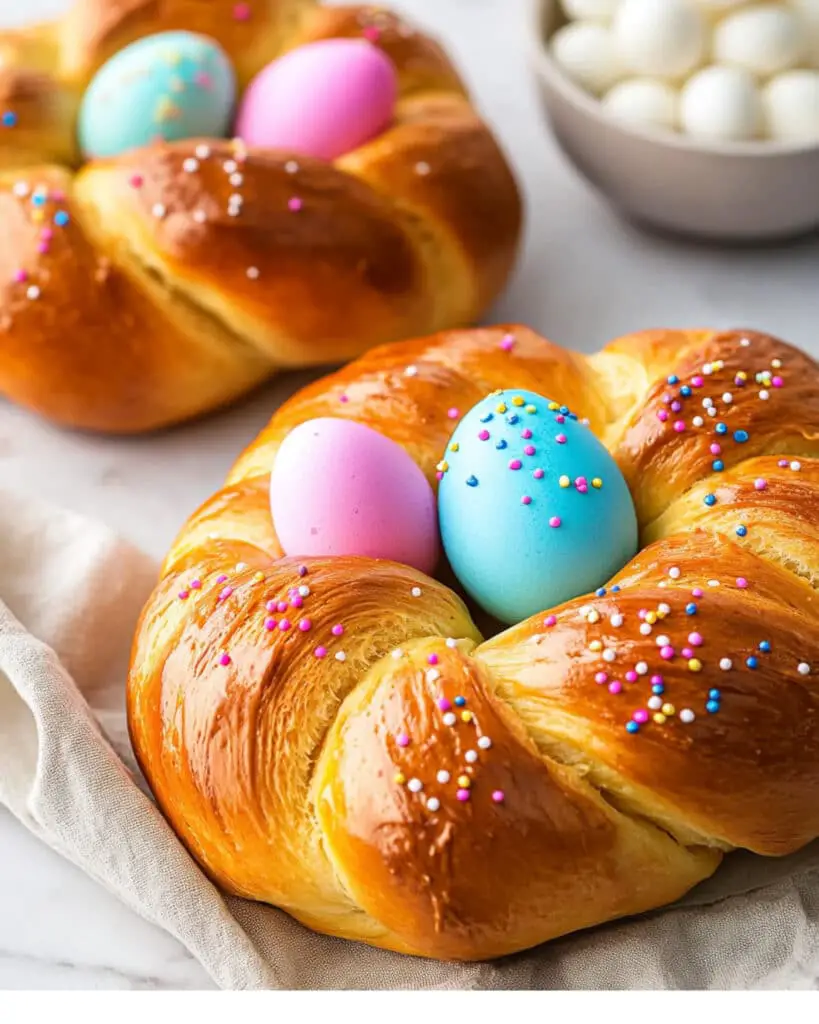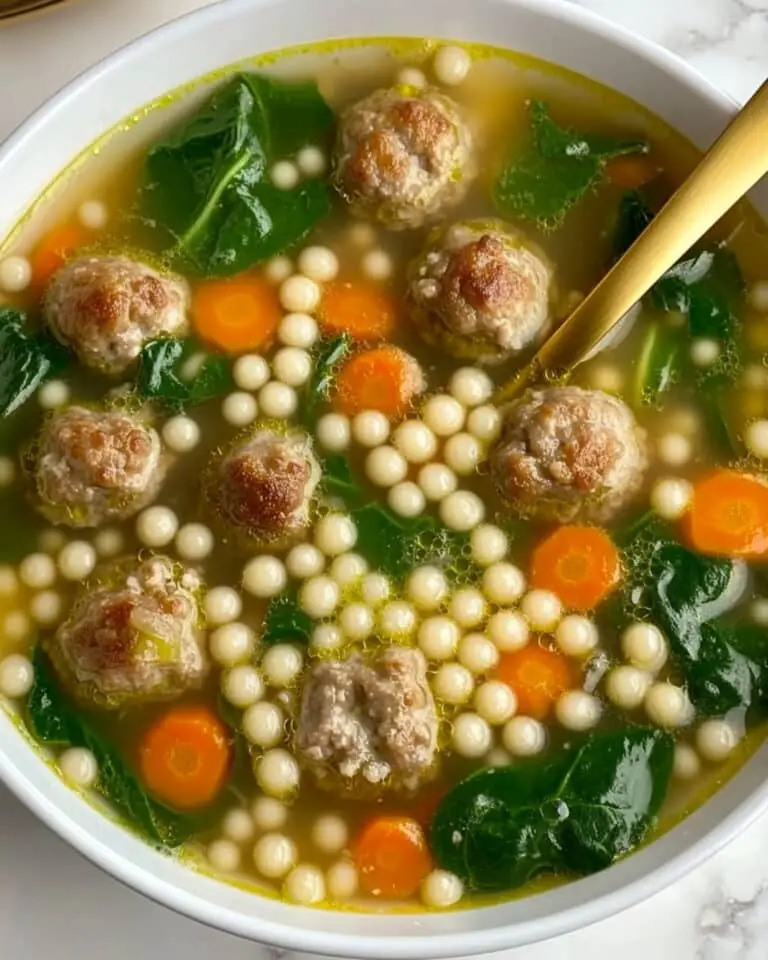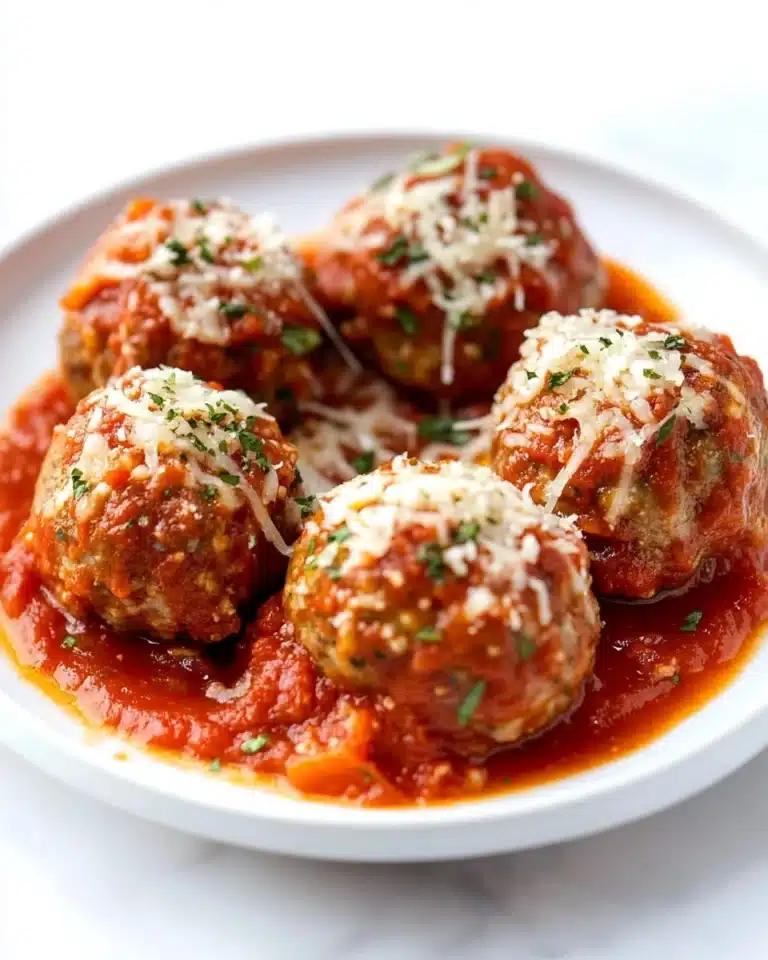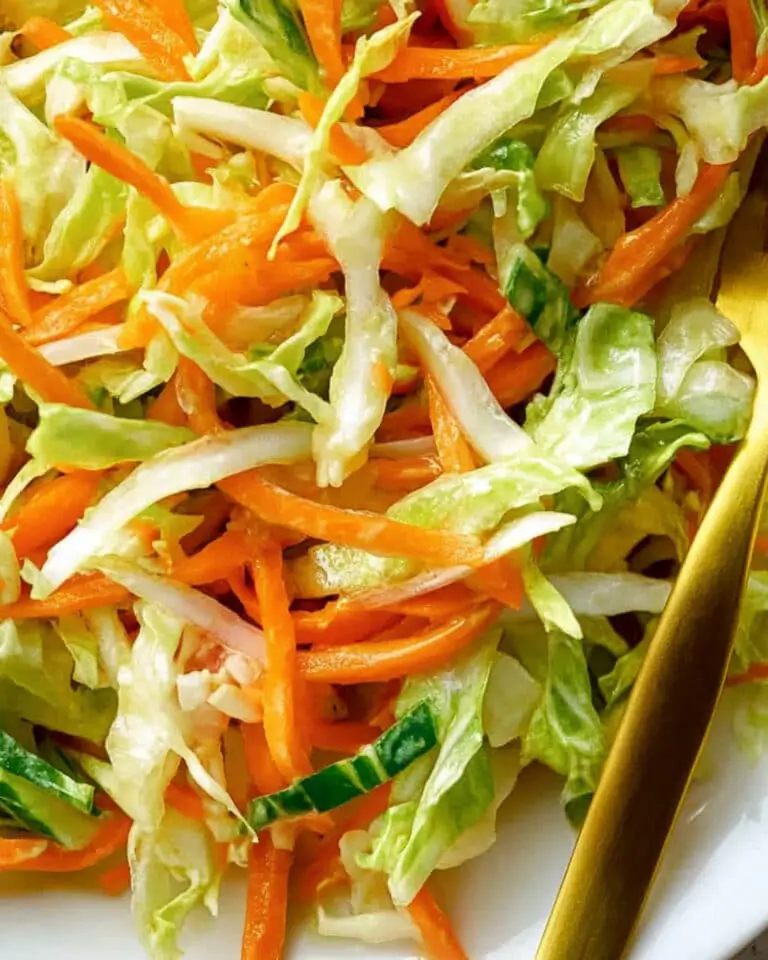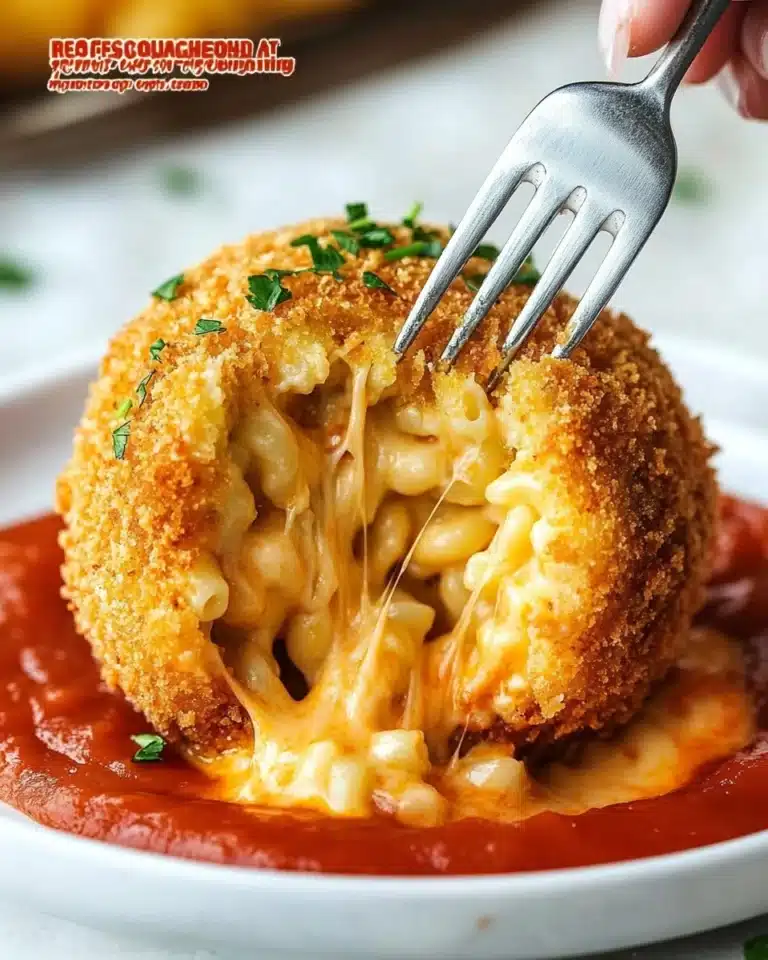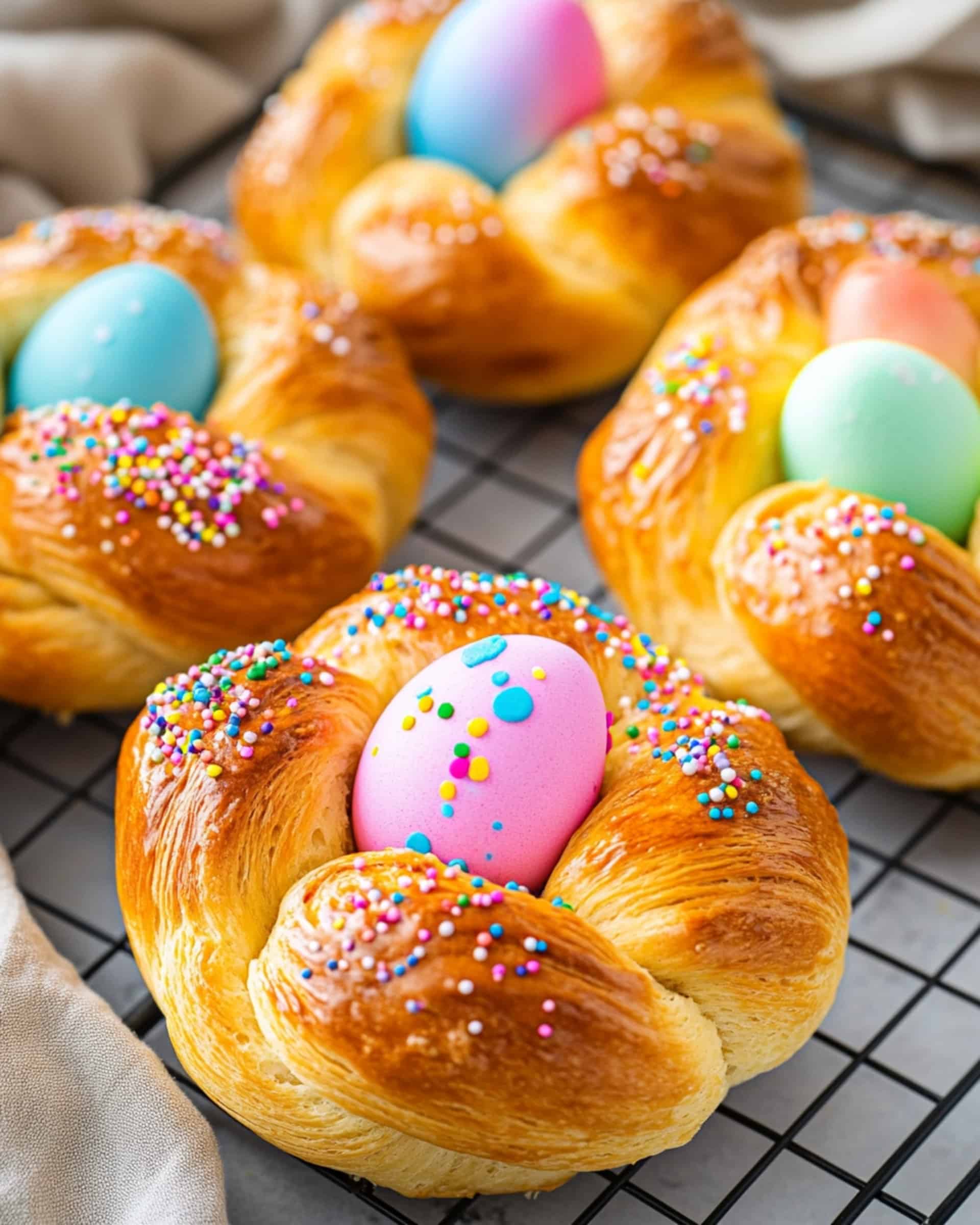
This traditional Easter Bread is a delightful sweet bread that’s braided into a beautiful ring with a colorful dyed egg nestled in the center. The bread is subtly flavored with citrus zest and vanilla, creating a fragrant and festive treat that’s as beautiful as it is delicious. Perfect for your Easter celebration or spring brunch!
Why You’ll Love This Recipe
- It’s a Showstopper: The beautiful braided ring with a colorful egg in the center makes for a stunning centerpiece on your Easter table.
- Easier Than It Looks: Don’t let the braided appearance intimidate you! This recipe breaks down the process into simple steps that even novice bakers can master.
- Wonderfully Versatile: You can customize the bread with different colored eggs and sprinkles to match your Easter décor or family preferences.
- Makes Great Memories: Baking this bread can become a cherished family tradition, with kids especially loving to help decorate the eggs and add sprinkles.
Ingredients You’ll Need
- Whole Milk: Provides moisture and richness to the dough, creating that soft, tender texture we’re looking for.
- Butter: Adds richness and flavor to the bread, giving it that melt-in-your-mouth quality.
- All-Purpose Flour: The structure of our bread – be ready to adjust slightly as needed for the perfect dough consistency.
- Granulated Sugar: Just enough to give the bread a gentle sweetness without making it overly dessert-like.
- Rapid Rise Instant Yeast: The magic ingredient that makes our bread rise quickly and reliably – no long waiting periods!
- Citrus Zest: The orange and lemon zest add a subtle brightness that makes this bread special and aromatic.
- Eggs: Provide structure, color, and richness to the dough (plus an extra one for the egg wash).
- Vanilla Extract: Adds warmth and depth to the flavor profile.
- Uncooked Dyed Easter Eggs: These become the centerpiece of each bread ring. They’ll cook to a soft-boiled consistency during baking.
- Colorful Sprinkles: Add festive flair and a touch of sweetness to the top of the bread.
Note: You’ll find the complete list of ingredients, along with their exact measurements, in the printable recipe card at the bottom of this post.
Variations
Different Shapes
Instead of rings, try making a braided loaf or individual mini nests with a small egg in each one.
Flavor Twists
Add cardamom or anise seeds for a more traditional European flavor, or mix in some dried fruits like golden raisins or cranberries.
Sweet Upgrade
Drizzle a simple glaze made from powdered sugar and milk over the cooled bread for extra sweetness.
Chocolate Version
Add chocolate chips to the dough or replace the traditional egg with a chocolate egg after baking.
How to Make Easter Bread
Step 1: Prepare the Dough Base
In a large mixing bowl, combine 2 cups of flour with the sugar, yeast, and both citrus zests. This mixture creates the fragrant foundation of your bread.
Step 2: Warm the Liquids
Heat the milk and butter in the microwave until warm but not hot. The liquid should feel like bath water – warm enough to activate the yeast without killing it. This usually takes about a minute with stirring intervals.
Step 3: Mix Wet and Dry Ingredients
Add the eggs, vanilla, and warmed milk mixture to your flour base. Mix with a dough hook until it resembles cake batter. This wet mixture ensures your bread will have that perfect soft texture.
Step 4: Add Remaining Flour
Gradually add the remaining 2 cups of flour while mixing. Keep going until you have a smooth dough that doesn’t stick to the bowl. Knead with the dough hook for about 8 minutes to develop the gluten, which gives your bread its structure.
Step 5: Form and Rest the Dough
Turn the dough onto a lightly floured surface, knead briefly by hand, and form into a ball. Place in a clean bowl, cover with plastic wrap, and let rest for 15 minutes. This short rest period allows the gluten to relax, making the dough easier to shape.
Step 6: Shape the Bread
Divide your dough into 8 equal pieces and roll each into an 11-inch rope. Take two ropes, pinch them together at one end, braid them, and form into a ring, pinching the ends together. This creates the beautiful nest-like shape that will cradle your Easter egg.
Step 7: Rise and Prepare
Place your braided rings on a parchment-lined baking sheet, cover with plastic wrap, and let rise in a warm spot for 30-60 minutes until doubled in size. Meanwhile, preheat your oven to 375°F.
Step 8: Add Final Touches and Bake
Brush the risen dough with egg wash, place an uncooked dyed Easter egg in the center of each ring, sprinkle with colorful sprinkles, and bake for 20 minutes, rotating halfway through for even browning.
Pro Tips for Making the Recipe
- Warm Rising Environment: Place your covered dough in a slightly warmed (then turned off) oven or near a warm spot in your kitchen to help it rise faster.
- Don’t Overflour: The dough should be slightly tacky but not sticky. Add flour gradually to avoid a dense bread.
- Braid Loosely: Remember the dough will expand during rising and baking, so don’t braid too tightly or your ring might lose its shape.
- Watch the Color: If your bread is browning too quickly, tent it with foil for the remainder of the baking time.
- Fun with Kids: Let children help with rolling the dough ropes and adding the sprinkles – just supervise the egg placement.
How to Serve
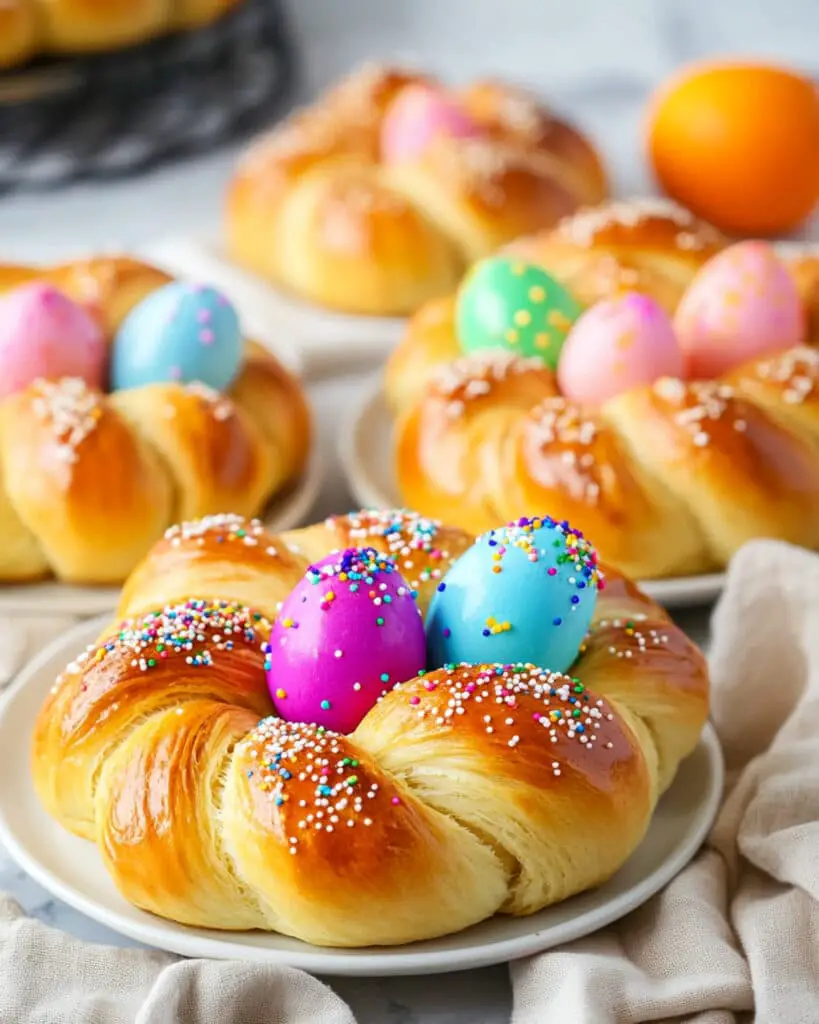
Perfect Pairings
Serve this slightly sweet bread with salted butter or honey butter for a delightful contrast. It also pairs wonderfully with coffee, tea, or hot chocolate.
Easter Brunch Star
Make it the centerpiece of your Easter brunch alongside savory dishes like frittatas, ham, or smoked salmon.
Gifting
Wrap a fully cooled bread in clear cellophane with a ribbon for a beautiful homemade Easter gift for neighbors, teachers, or family.
Make Ahead and Storage
Storing Leftovers
Once completely cooled, store the bread in an airtight container at room temperature for up to 3 days. For best food safety, remove the eggs and store them separately in the refrigerator if keeping at room temperature.
Refrigeration
The bread will stay fresh in the refrigerator for up to 5 days in an airtight container.
Freezing
Remove the eggs, then wrap the bread tightly in plastic wrap and foil or place in a freezer bag. Freeze for up to 3 months. Thaw overnight at room temperature before serving.
Reheating
To bring back that fresh-baked texture, warm bread slices in the oven at 300°F for about 5 minutes or give them a quick 10-15 seconds in the microwave.
FAQs
-
Can I use hardboiled eggs instead of uncooked eggs?
You can, but the texture of the egg will become quite firm and rubbery after baking. The uncooked eggs cook to a soft-boiled consistency during baking, which many people prefer. If using hardboiled eggs, add them to the bread about 5 minutes before the end of baking time to prevent overcooking.
-
How do I know when my dough has risen enough?
The dough should roughly double in size and feel soft and puffy. If you gently press a finger into it, the indentation should remain rather than spring back completely – this is known as the “finger test” and indicates proper rising.
-
Can I make the dough ahead of time?
Yes! You can prepare the dough and refrigerate it overnight after the first rise. Let it come to room temperature for about 30 minutes before shaping into braids. The cold fermentation actually enhances the flavor.
-
Is it safe to eat the eggs that are baked in the bread?
Yes, the eggs cook during the baking process to approximately a soft-boiled consistency. If you prefer firmer eggs, you can pre-boil them for a few minutes before dyeing and baking. Remember to refrigerate leftovers with eggs.
Final Thoughts
This Easter Bread isn’t just a recipe – it’s a celebration on a plate! The process of creating these beautiful braided rings, with their colorful eggs nestled in the center, brings as much joy as eating the finished product. The bread itself has a wonderful texture – soft and slightly sweet with hints of citrus that make it special without being overpowering. Whether this becomes part of your annual Easter tradition or a springtime treat you make just because, I know you’ll love both making and sharing it with those you care about.
Print
Easter Bread Recipe
- Prep Time: 1 hour
- Cook Time: 45 minutes
- Total Time: 2 hours 5 minutes
- Yield: 4 pieces
- Category: Bread
- Method: Baking
- Cuisine: European
Description
Celebrate spring and Easter with this delightful and festive Easter Bread! Soft, fluffy, and subtly infused with citrus flavors from lemon and orange zest, this traditional braided bread is not only beautiful but also irresistibly delicious. A perfect treat to share with family and friends, adorned with dyed eggs and colorful sprinkles for a seasonal touch. It’s a show-stopping centerpiece for your Easter table, but also a treat that can bring joy year-round.
Ingredients
For the Dough
- 1 cup whole milk
- 1/4 cup butter
- 4 cups all-purpose flour (divided: 2 cups and 2 cups)
- 1/3 cup granulated sugar
- 2 1/4 teaspoons rapid rise instant yeast (1 package)
- Zest of 1 lemon
- Zest of 1 orange
- 2 eggs
- 1 teaspoon vanilla extract
For the Egg Wash
- 1 egg
- 1 teaspoon milk
Decorations
- Dyed Easter eggs (uncooked – NOT hardboiled)
- Colorful sprinkles
Instructions
- Mix Dry Ingredients
In a large mixing bowl, combine 2 cups of the flour with the granulated sugar, yeast, salt (if using), and the lemon and orange zest. Mix these dry ingredients together with a spoon to fully integrate the flavors. Set aside. - Prepare Milk and Butter
Place the butter and milk into a microwave-safe bowl or measuring cup. Heat the mixture in the microwave in 10-second intervals after an initial 1-minute warming, stirring each time, until warm and melted. Avoid overheating. - Combine Wet Ingredients
Add the eggs, vanilla extract, and warmed milk mixture into the bowl with the dry ingredients. Using a stand mixer with a dough hook, mix the ingredients until they form a batter-like consistency (about 1 minute). - Incorporate Remaining Flour
Gradually add the remaining 2 cups of flour to the stand mixer. Continue to mix with the dough hook until the dough becomes smooth and no longer sticks to the bowl’s sides. If necessary, add additional flour (1 tablespoon at a time) to achieve the right texture. Knead for about 8 minutes. - Knead Dough
Transfer the dough to a lightly floured surface or a silicone mat. Knead it by hand a few times to shape it into a ball, using minimal flour to manage stickiness. - Rest the Dough
Place the dough ball into a clean bowl and cover it with plastic wrap. Let it rest for 15 minutes. - Shape the Dough
Remove the dough from the bowl and punch it down to release any air. Divide it into 8 equal pieces. Roll each piece into a rope roughly 11 inches in length. Pinch two ropes together at one end, braid them, and then form the braid into a ring, pinching the ends together to seal. - Proof the Dough
Place the braided rings on a parchment-lined baking sheet. Cover them with plastic wrap and let them rise in a warm spot for 30 minutes to 1 hour, or until doubled in size. - Preheat Oven
While the dough is rising, preheat your oven to 375℉ (190℃). - Apply Egg Wash
In a small bowl, whisk together the egg and milk to create an egg wash. Use a pastry brush to coat the surface of the risen dough rings with the egg wash. - Decorate and Bake
Gently nestle a dyed, uncooked Easter egg into the center of each ring. Sprinkle colorful sprinkles over the top to decorate. Bake for 20 minutes, rotating the baking sheet halfway through for even baking. The eggs will cook to a soft-boiled consistency during the baking process. - Cool and Serve
Allow the baked rings to cool on a wire rack. These fluffy Easter Bread rings are best enjoyed warm but are delicious at any temperature.
Notes
- Storage Tips: Once cooled, store the bread in an airtight container at room temperature for up to 3 days, or in the refrigerator for up to 5 days. If storing at room temperature, remove the eggs and store them in the fridge to maintain freshness. For longer storage, place bread (without the eggs) in a freezer bag and freeze for up to 3 months.
- Alternative Decorations: If you prefer not to use real eggs, you can bake the bread with plain white or brown eggs and replace them after baking with chocolate eggs or small treats for an additional surprise—perfect for kids!
Nutrition
- Serving Size: 1 piece
- Calories: 350
- Sugar: 6g
- Sodium: 120mg
- Fat: 8g
- Saturated Fat: 5g
- Unsaturated Fat: 3g
- Trans Fat: 0g
- Carbohydrates: 53g
- Fiber: 2g
- Protein: 10g
- Cholesterol: 65mg

